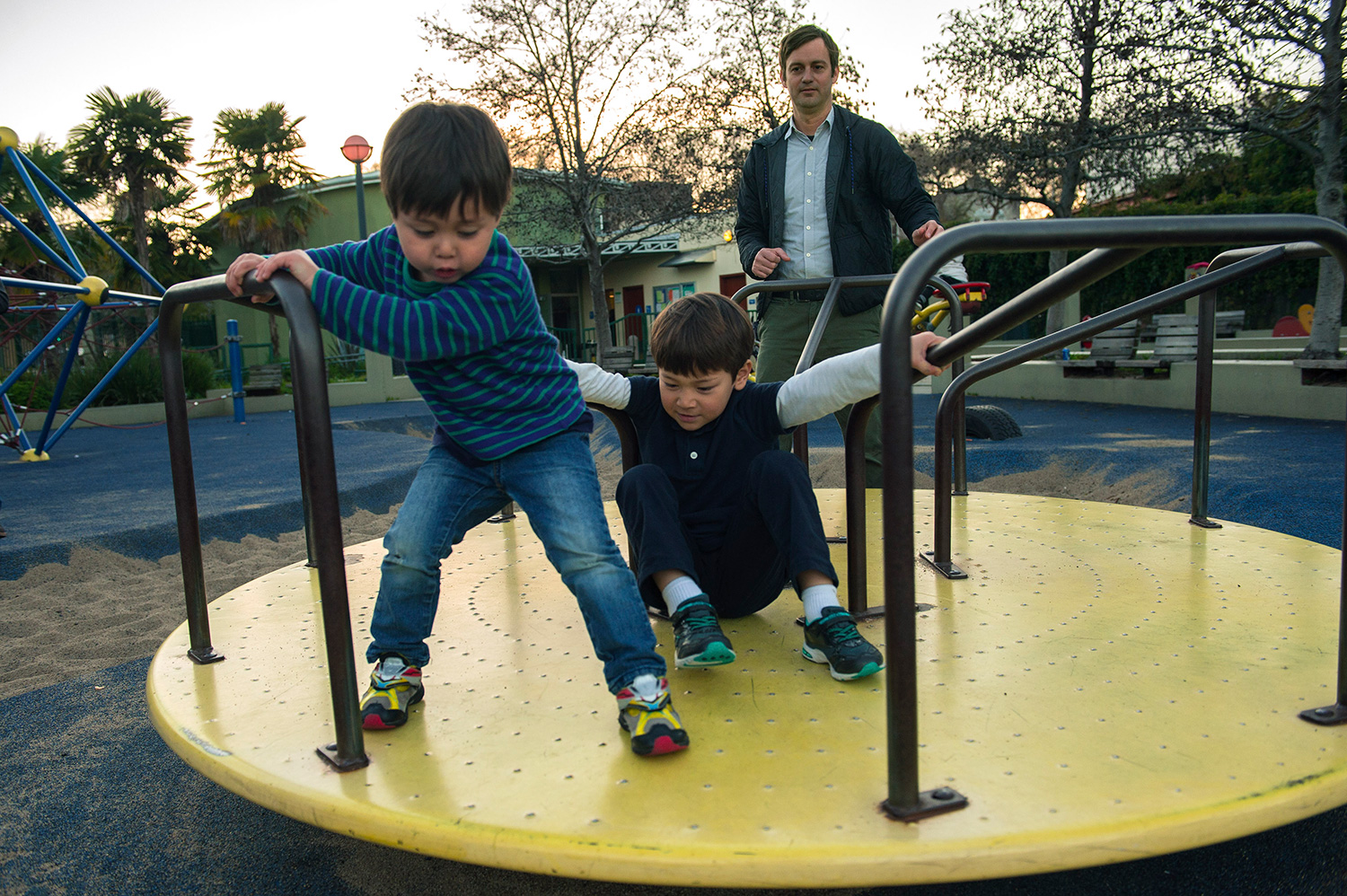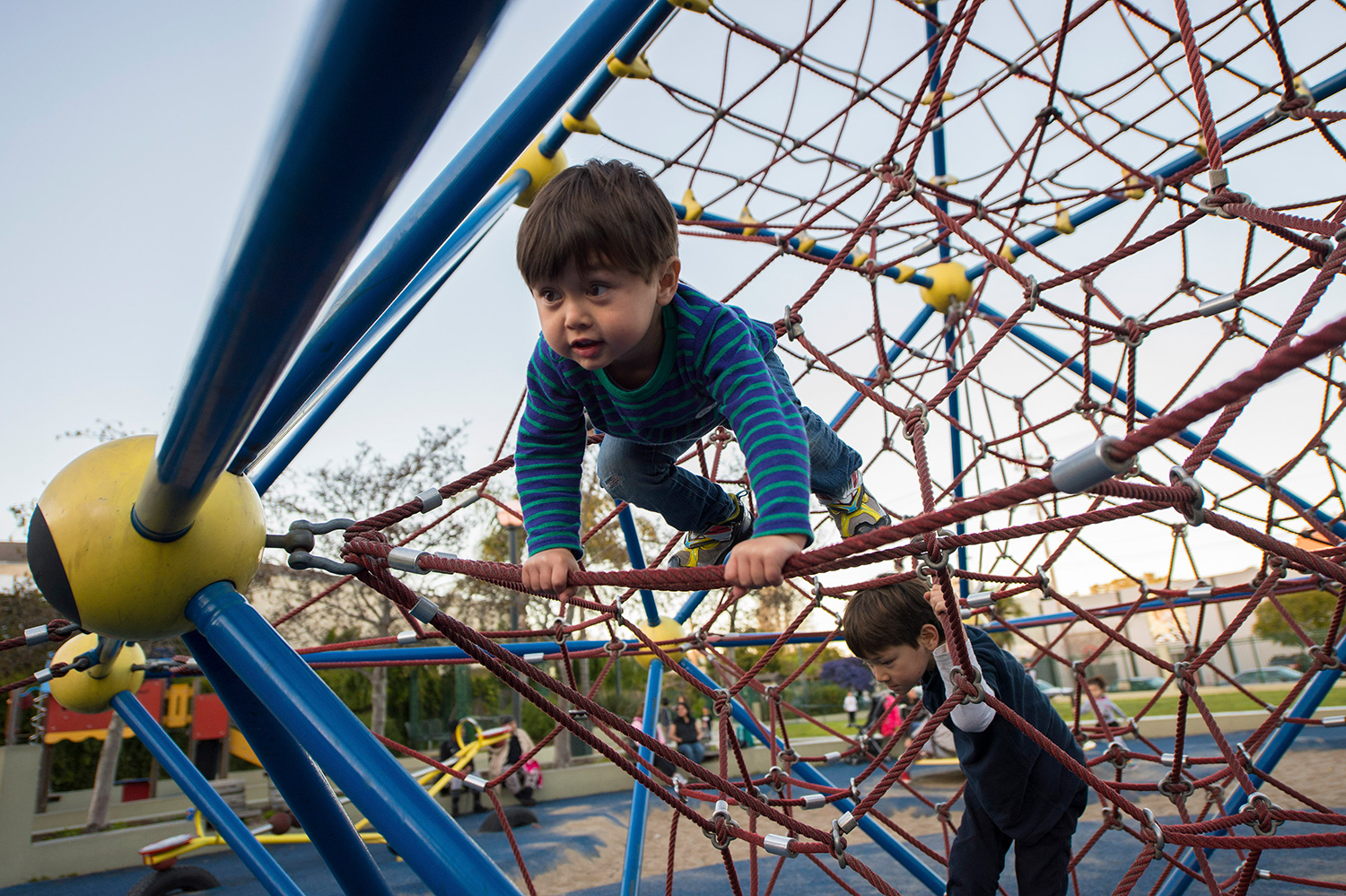


Bobby lets his children Colter, 5, and Emmett, 3 play at a park in the Mission district in San Francisco.

Bobby watches, as Colter is about to jump.

Emmett who also doesn’t hesitate to try out his next challenges makes his mom “worried about injuries all the time,” said Miyuki.

The family: Bobby Watts and Miyuki Noma, and their children Colter and Emmett.
San Francisco residents Bobby Watts and his wife, Miyuki Noma believe that the most difficult issue for raising children in San Francisco is finding quality child care.
Bobby Watts has lived in San Francisco for over twenty years, and Miyuki moved to the city from Japan about a decade ago. The couple met, fell in love, and married. They live in the Mission District of San Francisco and are raising their two children, Colter, 5, and Emmett, 3. Colter is in a public kindergarten class in San Francisco, and Emmett is in private pre-school.
For a family, the difficulty raising kids starts with the prohibitive cost of daycare for their children and pre-school.
After a considerable about of research, Miyuki was able to find a home daycare to take their children to when they were very young. She decided on an individual day care professional to take care of their children. The day care provider and an adult assistant watch six children daily.
Miyuki and Bobby then explored all the preschool options in San Francisco.
They visited a lot of pre-schools and Japanese bi-lingual schools in the city and ended up choosing a preschool close to where they live.
The private preschool they chose had a Reggio Emilia ( https://en.wikipedia.org/wiki/Reggio_Emilia_approach ) approach to education. According to Wikipedia a Reggio Emila approach ‘is based on the principles of respect, responsibility, and community through exploration and discovery in a supportive and enriching environment based on the interests of the children through a self-guided curriculum.’
In the preschool “children choose what they want to do,” noted Miyuki.
After their children had started attending preschool, Bobby and Miyuki turned their attention to finding a good public elementary school for them in San Francisco. Like all parents, they had to enter a lottery system in the San Francisco public schools to find a placement for Colter.
“Every parent has to put down the name of the elementary school that they want you to put your child in,” explained Miyuki. “We were lucky because the area we live in is considered a low test score area. That means that the people who live in that area will get priority for the lottery. We got into our first choice elementary school.”
The lottery “Is to more evenly distribute and diversify all of the different school programs [in San Francisco],” added Bobby.
Their first choice for Colter’s public school education was Rosa Parks Elementary ( https://rosaparks-sfusd-ca.schoolloop.com/ ). The school has a Japanese Bilingual Bicultural Program that starts in kindergarten. It is considered the best in the public schools of San Francisco.
“You really go on a feeling,” explained Bobby about their choice of school. “It’s very overwhelming because you have to visit ten or fifteen schools. Some were really good schools, but they heard questionable things about it, but it has really good scores. For Rosa Parks, the Japanese Bilingual program was important, but it was very diverse, and we liked the teachers and how the school is managed. It seemed like a good choice for all of those reasons.”
According to ( http://www.greatschools.org/california/san-francisco/6420-Parks-Rosa-Elementary-School/ ), Rosa Parks is 26 percent black, 23 percent Asian, 19 percent Hispanic, 17 percent White, and 12 percent Mixed Race. The 55 percent of the students are from low-income families.
Another challenge raising children in San Francisco was the cost of living. “There are a lot of things that are available, but some of them are annoying,” said Bobby. “The California Academy of Science is really expensive. It’s a city-managed museum. It shouldn’t cost your 200 dollars to take your family there, but it does.”
They have a family membership at the Bay Area Discovery Museum and the San Francisco Zoo because they go to both locations multiple times. They also just signed up Colter in the San Francisco baseball little league.
“We want to give the exposure to as many things as possible,” said Bobby. “And we just want them to play and have fun.” He wants them to be exposed to math, science and the arts and also sports activities as well.
There are other trade-offs to living in San Francisco. Although there are parks near their house, some of them have drug addicts hanging out in them. They often find used surgical needles in the park.
“We love living in San Francisco. It’s a really great city,” said Bobby. “The work-life balance is a little challenging. But there are a lot of things to do, and we feel safe.”
To give her additional parenting support, Miyuki joined the Golden Gate mother’s group ( http://www.ggmg.org/ ). She said it is an excellent organization to meet other parents in San Francisco.
Miyuki and Bobby never talked to children about respecting diversity, because San Francisco is such a diverse city. Their children are also multi-racial being half Asian, half European ancestry. Miyuki noted that the public schools educate students about diversity, especially since Donald Trump became President of the United States.
“We’re not happy with the President. I feel really lucky to live in the Bay Area because it’s diverse,” said Miyuki, “However, Carolina, Emmett’s daycare person, who is Hispanic, was taking six kids in the park. A white guy came up to her when she was with six kids and said ‘All of these kids you have they will be taken away.’ All she was worried about was that he was going to do something to the children. I was really angry about it. Kids are listening.”
Despite the challenges of living in a country when Donald Trump is President, Bobby and Miyuki remain hopeful for the children’s future. “[We want them to be] engaged in school, engaged in learning, and fulfilled,” Bobby said.
